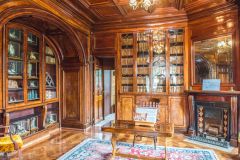
Long before tulips were grown here the area was used by the Romans for salt production. Finds at Wygate Park suggest that a combination of climate change and flooding of the low-lying South Holland landscape led to the salt industry dying out in the 3rd century.
In the 6th century, long after the departure of the Romans, the Spaldingas tribe settled in the area, and the town takes its name from the tribe. The town grew up on either side of the River Welland as it makes its way to The Wash. Flooding was a constant hazard until 1953 when the Coronation Channel diverted water around Spalding.

In 1015 a Benedictine priory was founded by a nobleman named Thorold de Bokenhale. In 1284 the prior of Spalding, William de Littleport, built a new church, dedicated to St Mary and St Nicholas, to serve the townsfolk. The striking tower and slender spire were added in 1360.
On Broad Street is the museum of the 'Gentleman's Society of Spalding', founded by Maurice Johnson in 1710, making it the second-oldest museum in Britain after the Ashmolean in Oxford. Famous members of the society include Lincolnshire native Sir Isaac Newton, Alexander Pope, and Richard Addison. A later member was architect Sir George Gilbert Scott, who designed St Paul's church in Fulney in 1880.

Maurice Johnson's former home of Ayscoughfee Hall, initially built in 1430, stands outside Spalding. The Hall is now operated as a museum.
In the Market Place stands the White Hart Inn, which was built around 1377. Mary, Queen of Scots, stayed at the White Hart in 1566.
On High Street is the Chain Bridge Forge, an early 19th-century blacksmith's workshop with displays on traditional smithing and Spalding's heritage. You can see metal objects being forged using traditional tools and techniques, and buy the objects in a small shop on site. The Forge gets its name from the nearby footbridge across the River Welland, which was originally supported by chains.

Another local landmark is the Gamlyn Almshouses on Church Street, built in 1501 and refounded in 1650 by Sir John Gamlyn. The Grade II listed almshouses were rebuilt in 1843 in Tudor Gothic style.
On the northern edge of town is the Pinchbeck Engine Museum. The engine was built in 1833 to help drain the Pinchbeck Marsh. It fell out of use in 1952 and has been transformed into a modern museum of Land Drainage. At the heart of the museum is the original 20 horsepower condensing steam engine, with a single cylinder, driving a 22-foot water wheel.
To the south is the Gordon Boswell Romany Museum, where you can see a large collection of richly painted, traditional Romany wagons.







 We've 'tagged' this attraction information to help you find related historic attractions and learn more about major time periods mentioned.
We've 'tagged' this attraction information to help you find related historic attractions and learn more about major time periods mentioned.




